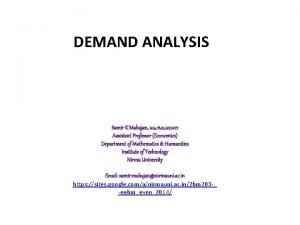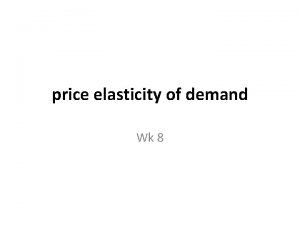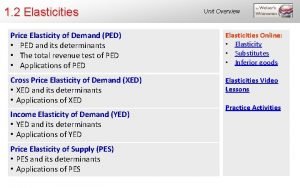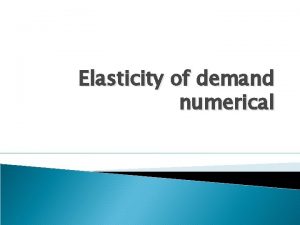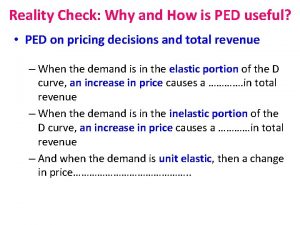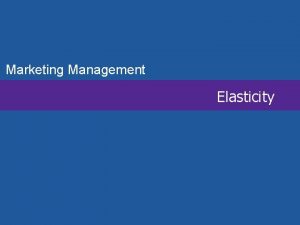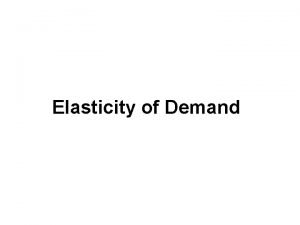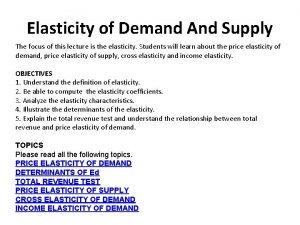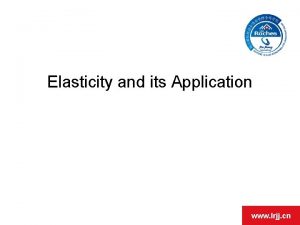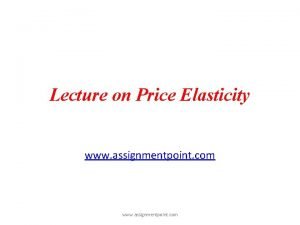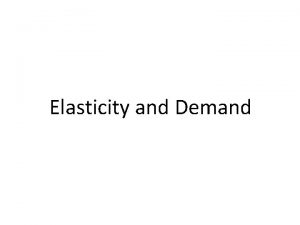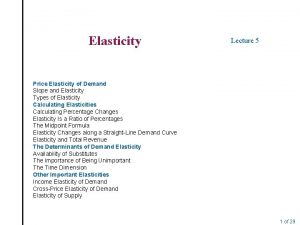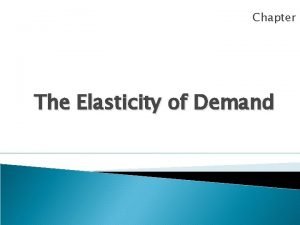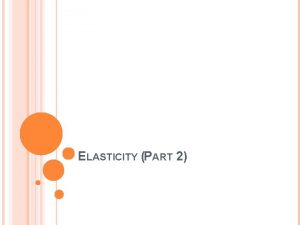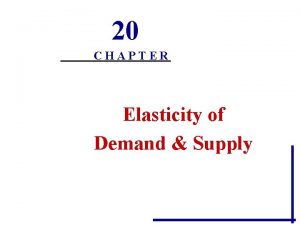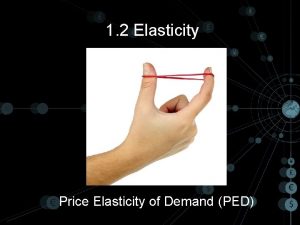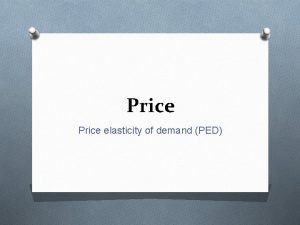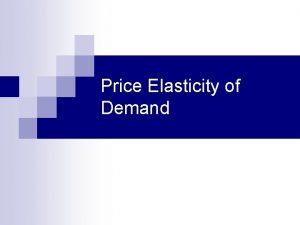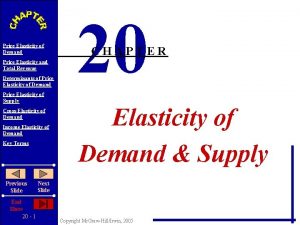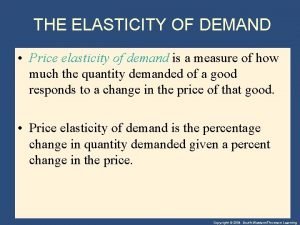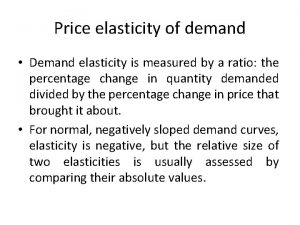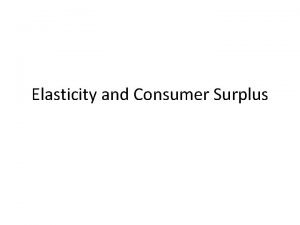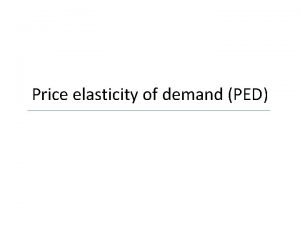Elasticity of demand Price elasticity of demand PED

















- Slides: 17

Elasticity of demand

Price elasticity of demand (PED) Key term: This measures the degree to which demand will change in response to a change in price PED = percentage change in quantity demanded percentage change in price • Elastic goods = an answer greater than 1, where demand will change with a price change • Inelastic goods = Less than 1, where demand is relatively unresponsive to a change in price • Unitary elasticity = an elasticity of 1; any price change is cancelled out by the demand change Elasticity will always be a negative figure as when price goes up demand falls and when prices fall demand rises. The relationship between these variables is opposite and therefore negative. AQA A-level Business © Hodder & Stoughton Limited 2015 2

Example A product increases its price from £ 100 - £ 110 and demand falls from 240 units to 180 units % change = Original figure – New figure x 100 Original figure • To calculate % change in price: (100 – 110)/100 * 100 = 10% • Then do the same for demand: (240 -180)/240 * 100 = -25% • Therefore using the equation PED = -25% / 10% = -2. 5 (Price elastic) Exam tip: There will be no need to calculate this in the examination AQA A-level Business © Hodder & Stoughton Limited 2015 3

Calculate whether demand is elastic or not: Price rises from £ 11 to £ 13 Demand falls from 76 units to 52 units.

An illustration of price elasticity AQA A-level Business © Hodder & Stoughton Limited 2015 5

An illustration of price elasticity AQA A-level Business © Hodder & Stoughton Limited 2015 6

An illustration of price elasticity AQA A-level Business © Hodder & Stoughton Limited 2015 7

Effect of price elasticity of demand on sales revenue and profit • Inelastic demand – if demand for a good is inelastic, when its price rises the quantity demanded falls by a smaller percentage. This means that the impact of the price increase will outweigh the relatively small percentage change in demand, so sales revenue will increase • As you are producing less, costs will be lower, so costs will fall as revenue increases • A PRICE RISE WILL ALWAYS INCREASE SALES REVENUE AND PROFIT IF PRICE ELASTICITY OF DEMAND IS INELASTIC • A PRICE FALL WILL LEAD TO LOWER SALES REVENUE AND PROFIT IF PRICE ELASTICITY OF DEMAND IS INELASTIC

• Elastic demand – if demand for a good is elastic, when its price rises the quantity demanded falls by a larger percentage. This means that the impact of the price increase will be outweighed by the relatively large percentage change in demand, so sales revenue will decrease • this doesn’t necessarily mean a decrease in profit • it will be cheaper to produce less goods so costs will fall as well as income • if costs fall by more than income, profit will still be improved • if costs fall by a smaller amount, profit will fall • THUS, A PRICE RISE WILL ALWAYS DECREASE SALES REVENUE IF PRICE ELASTICITY OF DEMAND IS ELASTIC, BUT THE EFFECT ON PROFIT WILL DEPEND ON COST SAVINGS • IN THE CASE OF A PRICE FALL, THE SALES REVENUE OF A GOOD WITH A PRICE ELASTIC DEMAND WILL ALWAYS INCREASE. HOWEVER, THE UANTITY DEMANDED RISES AND SO PRODUCTION COSTS WILL RISE. THEREFORE, IT IS IMPOSSIBLE TO PREDICT THE EFFECT ON PROFITS WITHOUT KNOWING THE COSTS OF PRODUCTION

• Unitary elasticity – if demand for a good is unitary, sales revenue will be the same whether price rises or falls • A price rise would then be advisable if the business is aiming to increase profit, because this means a lower volume of sales would be required, which would enable production costs to fall • However, the business may not increase price if it has other aims, such as increasing market share


Factors influencing price elasticity of demand • Necessity – the more necessary a product, the more inelastic the demand (e. g. Bread and milk) However, a reduction in price will not tend to encourage buyers to purchase more • Habit – the stronger the habit, the more inelastic the demand (e. g. Cigarettes, alcohol, chocolate, TV) • Availability of substitutes – the greater the availability of close substitutes, the more elastic the demand – think petrol in a city or the countryside • Brand loyalty – the greater the level of brand loyalty, the more inelastic the demand (e. g. Someone who insists on wearing Armani) • Proportion of income spent on a product – consumers will be less concerned about price rises if a product takes up a small percentage of their income and vice versa (e. g. Matches/cars) • Consumer income – Wealthier people are less worried about price increases. Wealthier areas can increase prices because demand for their products will be more inelastic • Time – if price changes, consumers will often look around for alternatives before deciding to switch to another product. Therefore, price changes tend to have less impact in the short term


Task: Price elasticity of demand 1. Produce a table (like the one below) that highlights the main factors that influence elasticity (Add others if not listed) Factors influencing price elasticity of demand How they influence elasticity Necessity or luxury good Habit forming Brand loyalty Proportion of income spent on the product Availability of substitutes 2. Two firms are competing in intense markets and are trying to improve their overall profit. Suggest how they should improve their competitiveness in terms of price and costs. a) An electronics firm with a PED of -0. 6 b) A handbag manufacturer with PED of -4. 3 AQA A-level Business © Hodder & Stoughton Limited 2015 14

Income elasticity of demand (IED) Key term: This measures the degree to which demand will change in response to a change in consumer income IED = percentage change in quantity demanded percentage change in income • Income elastic goods = an answer greater than 1, where demand will change by a more significant amount with a income change. Consumers will wish to purchase more as they become wealthier; usually luxury goods such as holidays and electrical goods. • Income inelastic goods = Less than 1, where demand is relatively unresponsive to a change in consumer income. Consumers do not generally demand a great deal more as they gain in income; usually necessity products, such as basic foods and fuel. • Unitary income elasticity = an elasticity of 1, any consumer income change is cancelled out by the demand change. Income elasticity will usually be a positive figure as when consumer income goes up demand will usually increase. However some goods known as inferior goods will have a negative IED as demand will fall as consumers’ incomes rise, e. g. supermarket own brands. Firms cannot control the levels of income in a market, so the main use of income elasticity is to forecast demand. AQA A-level Business © Hodder & Stoughton Limited 2015 15


Summary • There a wide variety of techniques discussed in this unit that firms can use to analyse their market. • For many it is essential to understand their market and consumers to ensure they anticipate and satisfy consumer demands to stay ahead of rivals. • Firms that are market-led aim to learn what consumers want and provide it. • However other firms focus more on an asset-led approach and produce unique products they know will change markets and that consumers will want, creating a sustainable competitive advantage. • The level of market analysis needed by a business and how successful it is will depend on the type of market the firm is in and the strengths of the business in terms of its staff, skills and brand. AQA A-level Business © Hodder & Stoughton Limited 2015 17
 Perfectly inelastic demand
Perfectly inelastic demand Midpoint method price elasticity of demand
Midpoint method price elasticity of demand Cross-price elasticity of demand formula
Cross-price elasticity of demand formula Cross price elasticity formula
Cross price elasticity formula Price elasticity of demand numericals
Price elasticity of demand numericals Cross price elasticity
Cross price elasticity Elasticity and its application in economics
Elasticity and its application in economics Price elasticity of supply
Price elasticity of supply Promotional elasticity of demand
Promotional elasticity of demand What are the 5 determinants of price elasticity of demand
What are the 5 determinants of price elasticity of demand Factors affecting price elasticity of demand
Factors affecting price elasticity of demand Formula for elasticity of supply
Formula for elasticity of supply Define income elasticity of demand
Define income elasticity of demand Income elasticity of demand table
Income elasticity of demand table How to calculate quantity demanded
How to calculate quantity demanded Marginal revenue formula
Marginal revenue formula What are the 5 determinants of price elasticity of demand
What are the 5 determinants of price elasticity of demand Price elasticity of supply measures how responsive
Price elasticity of supply measures how responsive
